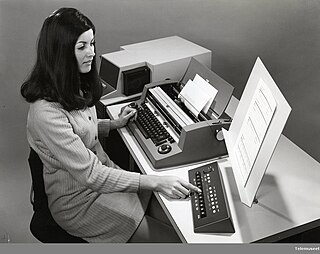Related Research Articles

A tape drive is a data storage device that reads and writes data on a magnetic tape. Magnetic-tape data storage is typically used for offline, archival data storage. Tape media generally has a favorable unit cost and long archival stability.

A teleprinter is an electromechanical device that can be used to send and receive typed messages through various communications channels, in both point-to-point and point-to-multipoint configurations.

Punched tape or perforated paper tape is a form of data storage device that consists of a long strip of paper through which small holes are punched. It was developed from and was subsequently used alongside punched cards, the difference being that the tape is continuous.

A computer terminal is an electronic or electromechanical hardware device that can be used for entering data into, and transcribing data from, a computer or a computing system. Most early computers only had a front panel to input or display bits and had to be connected to a terminal to print or input text through a keyboard. Teleprinters were used as early-day hard-copy terminals and predated the use of a computer screen by decades. The computer would typically transmit a line of data which would be printed on paper, and accept a line of data from a keyboard over a serial or other interface. Starting in the mid-1970s with microcomputers such as the Sphere 1, Sol-20, and Apple I, display circuitry and keyboards began to be integrated into personal and workstation computer systems, with the computer handling character generation and outputting to a CRT display such as a computer monitor or, sometimes, a consumer TV, but most larger computers continued to require terminals.

The IBM 729 Magnetic Tape Unit was IBM's iconic tape mass storage system from the late 1950s through the mid-1960s. Part of the IBM 7-track family of tape units, it was used on late 700, most 7000 and many 1400 series computers. Like its predecessor, the IBM 727 and many successors, the 729 used 1⁄2 inch (13 mm) magnetic tape up to 2,400 feet (730 m) long wound on reels up to 10+1⁄2 inches (270 mm) diameter. To allow rapid tape acceleration, long vacuum columns were placed between the tape reels and the read/write heads to absorb sudden increases in tape tension which would otherwise break the tape. Write protection was provided by a removable plastic ring in the back of the tape reel.

The UNISERVO tape drive was the primary I/O device on the UNIVAC I computer. It was the first tape drive for a commercially sold computer.

The Teletype Model 33 is an electromechanical teleprinter designed for light-duty office use. It is less rugged and cost less than earlier Teletype models. The Teletype Corporation introduced the Model 33 as a commercial product in 1963, after it had originally been designed for the United States Navy. The Model 33 was produced in three versions:
The 3480 tape format is a magnetic tape data storage format developed by IBM. The tape is one-half inch (13 mm) wide and is packaged in a 4 in × 5 in × 1 in cartridge. The cartridge contains a single reel; the takeup reel is inside the tape drive.

The IBM MT/ST was a model of the IBM Selectric typewriter, built into its own desk, integrated with magnetic tape recording and playback facilities, located in an attached enclosure, with controls and a bank of relays. It was released by IBM in 1964. It recorded text typed on 1/2" magnetic tape, approximately 25 kilobytes per tape cassette, and allowed editing and re-recording during playback. It was the first system marketed as a word processor. Most models had two tape drives, which greatly facilitated revision and enabled features such as mail merge. An add-on module added a third tape station, to record the combined output of playback from the two stations.
Binary Synchronous Communication is an IBM character-oriented, half-duplex link protocol, announced in 1967 after the introduction of System/360. It replaced the synchronous transmit-receive (STR) protocol used with second generation computers. The intent was that common link management rules could be used with three different character encodings for messages.

IBM's first magnetic-tape data storage devices, introduced in 1952, use what is now generally known as 7-track tape. The magnetic tape is 1⁄2 inch (13 mm) wide, and there are six data tracks plus one parity track for a total of seven parallel tracks that span the length of the tape. Data is stored as six-bit characters, with each bit of the character and the additional parity bit stored in a different track.

9-track tape is a format for magnetic-tape data storage, introduced with the IBM System/360 in 1964. The 1⁄2 inch (12.7 mm) wide magnetic tape media and reels have the same size as the earlier IBM 7-track format it replaced, but the new format has eight data tracks and one parity track for a total of nine parallel tracks. Data is stored as 8-bit characters, spanning the full width of the tape. Various recording methods have been employed during its lifetime as tape speed and data density increased, including PE, GCR, and NRZI. Tapes come in various sizes up to 3,600 feet (1,100 m) in length.
Magnetic-tape data storage is a system for storing digital information on magnetic tape using digital recording.
The IBM 2780 and the IBM 3780 are devices developed by IBM for performing remote job entry (RJE) and other batch functions over telephone lines; they communicate with the mainframe via Binary Synchronous Communications and replaced older terminals using synchronous transmit-receive (STR). In addition, IBM has developed workstation programs for the 1130, 360/20, 2922, System/360 other than 360/20, System/370 and System/3.

270x is a generic name for a family of IBM non-programmable communications controllers used with System/360 and System/370 computers.
Synchronous transmit-receive (STR) was an early IBM character-oriented communications protocol which preceded Bisync. STR was point-to-point only, and employed a four-of-eight transmission code, communicating at up to 5100 characters per second over half-duplex or full-duplex communication lines.

Viatron Computer Systems Corporation, or simply Viatron was an American computer company headquartered in Bedford, Massachusetts, and later Burlington, Massachusetts. Viatron coined the term "microprocessor" although it was not used in the sense in which the word microprocessor is used today.
Information Control Systems was a computer programming and data processing company serving clients in the Midwestern United States.

The PDP-8/e was a model of the PDP-8 line of minicomputers, designed by the Digital Equipment Corporation to be a general purpose computer that inexpensively met the needs of the average user while also being capable of modular expansion to meet the more specific needs of advanced user.
References
- 1 2 IBM Corporation (1961). IBM 7702 Magnetic Tape Transmission Terminal (PDF). p. 00.
- ↑ Pugh, Emerson W.; Johnson, Lyle R.; Palmer, John H. (1991). IBM's 360 and Early 370 Systems. Cambridge, MA.: The MIT Press. pp. 601. ISBN 0-262-16123-0.